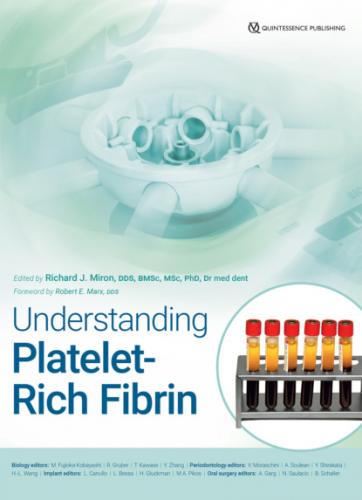Understanding Platelet-Rich Fibrin. Richard J. Miron
ms
Private Practice Limited to Oral Surgery Buffalo Grove, Illinois
Yoshinori Shirakata, dds, phd
Associate Professor, Department of Periodontology
Kagoshima University Graduate School of Medical and Dental Sciences
Kagoshima, Japan
Miguel Stanley, dds
Private Practice
Lisbon, Portugal
Robert Talac, md, phd
Director, Renaxis Spine and Orthopedic Clinic
Houston, Texas
Mustafa Tunali, dds, phd
Professor, Department of Periodontology
Haydarpasa Training Hospital
Gulhane Military Medical Academy
Istanbul, Turkey
Delia Tuttle, dds, ms
Private Practice
Lake Elsinore, California
Hom-Lay Wang, dds, msd, phd
Professor and Director of Graduate Periodontics
Department of Periodontics and Oral Medicine
University of Michigan School of Dentistry
Ann Arbor, Michigan
Hudi Xu, dds, phd
Research Associate, Department of Dental Implantology
School of Stomatology
Wuhan University
Wuhan, China
Yufeng Zhang, md, dds, phd
Professor, Department of Dental Implantology
School of Stomatology
Wuhan University
Wuhan, China
The abbreviations listed here are used throughout the book and are NOT always spelled out in the chapters for ease of reading.
| ALP | alkaline phosphatase |
| AM | amniotic membrane |
| A-PRF | advanced PRF |
| BoP | bleeding on probing |
| BMP | bone morphogenetic protein |
| CAF | coronally advanced flap |
| CAL | clinical attachment level |
| CBC | complete blood count |
| CEJ | cementoenamel junction |
| C-PRF | concentrated-PRF |
| CTG | connective tissue graft |
| DBBM | deproteinized bovine bone mineral |
| DFDBA | demineralized freeze-dried bone allograft |
| ECM | extracellular matrix |
| EDTA | ethylenediaminetetraacetic acid |
| EGF | epidermal growth factor |
| EMD | enamel matrix derivative |
| e-PRF | extended-PRF |
| ePTFE | expanded polytetrafluoroethylene |
| FDA | US Food and Drug Administration |
| FDBA | freeze-dried bone allograft |
| GBR | guided bone regeneration |
| GF | growth factor |
| H&E | hematoxylin-eosin stain |
| hPDLC | human periodontal ligament cell |
| H-PRF | PRF obtained through horizontal centrifugation |
| IGF | insulinlike growth factor |
| IL | interleukin |
| i-PRF | injectable-PRF |
| ISQ | implant stability quotient |
| KTW | keratinized tissue width |
| L-PRF | leukocyte PRF |
| LPS | lipopolysaccharide |
| LSCC | low-speed centrifugation concept |
| mRNA | messenger RNA |
| MRONJ | medication-related osteonecrosis of the jaw |
| MSC | mesenchymal stem cell |
| OFD | open flap debridement |
| ONJ | osteonecrosis of the jaw |
| PD | probing depth |
| PDGF | platelet-derived growth factor |
| PPE | personal protective equipment |
| PPP | platelet-poor plasma |
| PRF | platelet-rich fibrin |
| PRGF | plasma rich in growth factors |
| PRP | platelet-rich plasma |
| PTFE | polytetrafluoroethylene |
| RBC | red blood cell |
| RBH | residual bone height |
| RCF | relative centrifugal force |
| RCT | randomized controlled trial |
| rpm | revolutions per minute |
| RT-PCR | real-time polymerase chain reaction |
| SD | standard deviation |
| SE | standard error |
| SEM | scanning electron microscopy |
| TGF-β | transforming growth factor β |
| TMJ | temporomandibular joint |
| TNF-α | tumor necrosis factor α |
| T-PRF | titanium-prepared PRF |
| VEGF | vascular endothelial growth factor |
| WBC | white blood cell |
Evolution of Platelet Concentrates
Contributors
Richard J. Miron
Chapter Highlights
Evolution of PRF and the reasons for its discovery
Discussion of PRP vs PRGF vs PRF vs L-PRF, A-PRF, etc
Biologic background of key steps involved during wound healing
Platelet concentrates were derived more than 20 years ago following the discovery that platelets themselves act as key regulators during the wound healing process. Initial attempts were first made to concentrate these cells using anticoagulants and a centrifugation device; the resulting biomaterial was called platelet-rich plasma (PRP). Shortly thereafter, protocols were developed with the aim of avoiding the use of anticoagulants altogether, because clotting is a pivotal step during the wound healing cascade; the resulting biomaterial was called platelet-rich fibrin (PRF). Today, platelet concentrates have become incredibly relevant worldwide, with their use spanning across nearly every field of regenerative medicine. Furthermore, one of the main growth factors (GFs) found in platelets—platelet-derived growth factor (PDGF)—has been commercialized as a ready-made laboratory recombinant protein under the trade name GEM 21S (Lynch Biologics). Thus, as medicine has continued to evolve and progress, an obvious and clear trend favoring GF use has been established. Furthermore, by modifying centrifugation devices and spin protocols of PRP/PRF, a greater ability to concentrate not only platelets but also leukocytes became possible, further favoring tissue regeneration. This chapter takes a deep look at the years of research leading to the significant advancement that has been made in this field. The evolution from PRP to PRF, including pioneering concepts such as the low-speed centrifugation concept and horizontal centrifugation, are discussed in terms of their ability to favor higher cell content, GF concentration, and ultimately better wound healing.
Platelet concentrates have been utilized in medicine for over two decades because of their ability to rapidly secrete autologous GFs and ultimately speed wound healing. They have gained tremendous momentum as a regenerative agent derived from autologous sources capable of stimulating tissue regeneration in a number of medical fields.1,2 Many years ago, it was proposed that by concentrating platelets using a centrifugation device, GFs derived from blood could be collected from a platelet-rich plasma layer and later utilized
